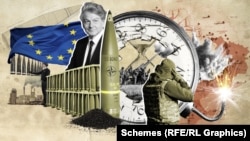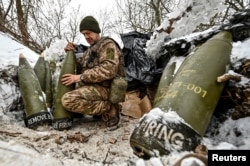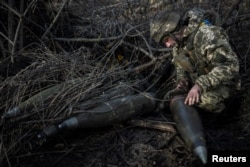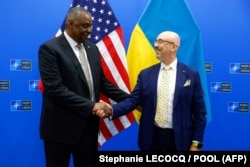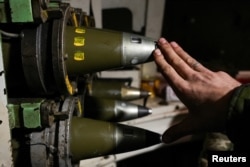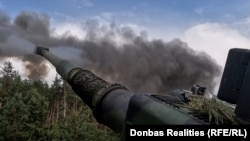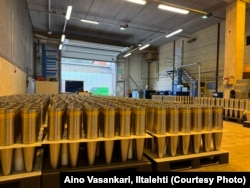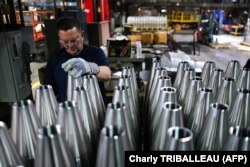The European Union's capacity to produce 155 mm artillery ammunition may be less than half as large as public estimates by senior EU officials indicate, affecting the bloc's ability to keep promises about supplies to Ukraine, Schemes and its partners in a journalistic investigation have found.
The finding is a result of months of reporting by Schemes -- the investigative unit of RFE/RL's Ukrainian Service -- and other outlets in a consortium of European media on shell production, a crucial factor in Ukraine's defense against the Russian invasion.
In addition to the capacity issue, interviews with ammunition producers, buyers, government officials, policy advisers, and defense experts in EU member states and Ukraine showed that the EU has given Ukraine about half as many shells as it has promised, with a significant delay.
In March, the European Commission said that thanks to its measures, European annual production capacity for 155 mm shells had reached 1 million a month earlier.
Three months later, in June, Thierry Breton, the European commissioner for the internal market, said that EU producers would reach an annual capacity of 1.7 million 155 mm shells by the end of this year and that capacity would continue to grow. However, according to a high-ranking European arms industry source, the current capacity is about one-third of this.
"It's a very bad idea to convince ourselves that we have three times the actual production capacity and make decisions based on that. Then suddenly to find out that nothing is coming out of the factories and you cannot supply Ukraine and the NATO alliance," the source said.
Like some others cited in this report, the source spoke on condition of anonymity due to the sensitivity of the subject.
This testimony aligns with that of two other knowledgeable industry sources journalists spoke to in June -- high-level officials in an EU country and in Ukraine -- who assessed the annual capacity of European 155 mm ammunition production at over half a million.
"Declarations of the EU leaders regarding the 155 mm production capacity that is to be reached by the end of this year are not reasonable. Production increases across Europe are lagging behind, with the current total capacity reaching about 580,000 shells per year," said a well-informed artillery industry source from Slovakia.
Two other documents estimate the European industry's annual capacity as of the beginning of the year at not much higher than half a million.
According to a December 2023 Estonian Defense Ministry report, the EU production capacity is about 600,000 shells a year. This fits with German arms maker Rheinmetall's January 2024 estimate, an internal document that journalists obtained, which says that all Western European arms makers taken together could produce around 550,000 shells annually as of the beginning of this year.
In response to questions from the journalistic consortium, the European Commission said that it based its assessment of the European ammunition production capacity on "facts" and that it was "taking into account ongoing investments" into the industry's scale-up.
The consortium -- which includes Schemes, Germany's Die Welt, Czech outlet Investigace.CZ, Poland's Vsquare and Frontstory.PL, Finland's Iltalehti, Slovakia's Jan Kuciak Investigative Center, Delfi Estonia, and The Investigative Desk -- examined the factors behind the pace of European ammunition-production capacity building.
Arms companies said the problem is a global shortage of gunpowder and explosives and a lack of cash to fuel the ammunition industry, with governments reluctant to sign long-term contracts.
High-ranking governmental and industry sources with whom Schemes and its partners spoke blamed ammunition shipment delays to Ukraine on EU bureaucracy and sluggishness and asserted that inadequate EU assessments of its own production capacity were among the causes of lagging supplies.
Ukraine is purchasing some ammunition on its own and plans to start mass production of 155 mm shells in the second half of 2024.
However, Strategic Industries Minister Oleksandr Kamyshin said that Ukraine's efforts will always be insufficient: "We will never be able to produce as much ammunition as our armed forces need now," he told Schemes.
The current need is 200,000 shells a month, according to Defense Minister Rustem Umerov -- more than the EU and the United States combined can manage.
"The entire free world cannot meet this need because we have an active front line of 1,500 kilometers, which has not happened since the Second World War," Kamyshin said.
The U.S. presidential election in November is adding to concerns in Kyiv about future aid and arms deliveries.
The Game Changer
NATO-standard artillery has been a game-changer on the front line, former Defense Minister Oleksiy Reznikov says.
Ukraine, which inherited Soviet artillery, received the first substantial batches of 155 mm artillery guns and shells in the spring of 2022, not long after Russia launched the full-scale invasion on February 24.
However, this didn't happen in a flash.
As Russian forces massed at the border before the invasion, Kyiv and its partners were searching for Soviet-caliber ammunition for the country's defense. Ukraine had roughly 1,000 pieces of 122 mm and 152 mm artillery and only one 155 mm NATO-standard howitzer, the Bohdana, domestically produced and at the time only a test sample.
Knowing this, the United States offered Ukraine Soviet ammunition it bought for Afghanistan and stored across the EU, Reznikov told Schemes.
"We negotiated with the Americans and received full access to all their warehouses in Europe that they had accumulated ammunition for the operation in Afghanistan," he said.
This ammunition helped Ukraine hugely, he said, but it didn't last long.
Soon, it became clear that Europe's limited capacity to produce Soviet-caliber ammunition could not keep up with demand. According to Reznikov, in the early days of the all-out war, Ukraine used 20,000 shells of all available calibers – one-third of what Russia fired but 12 times more Soviet-caliber shells than Europe could make in a day.
In spring 2022, Ukraine persuaded Britain and the United States to give it 155-caliber artillery and shells. Other countries followed suit.
Ukraine now has at least 12 types of 155 mm artillery from around the globe, Schemes found, in addition to the Bohdana. The total number of 155 mm artillery pieces at Ukraine's disposal rose from one at the start of the invasion to 500 to 600 now, said Mykola Byelyeskov, a research fellow at the National Institute for Strategic Studies in Kyiv and a senior defense analyst at the charitable foundation Come Back Alive, which supports Ukraine's military.
Reznikov said that 155 mm artillery is more accurate, technologically advanced, and longer-range than the 152 mm Soviet equivalent. Most important, NATO countries had more of it.
Soldiers Schemes interviewed at the front in the Kharkiv Oblast said that since they switched from Soviet artillery to NATO guns, they have experienced less drastic ammunition shortages.
"At the beginning of the full-scale war, when we worked with 152 mm caliber artillery, we had to save up shells because we could not always get them in time, and they were not always available," said Artur, an artilleryman with Ukraine's 40th Separate Artillery Brigade.
Since he switched to an AHS Krab, a Polish 155 mm howitzer, ammunition shortages have become less of a problem.
"It can do anything. It can hit absolutely any target. It can be a stronghold, a pillbox, dugouts, houses, heavy, medium, light vehicles, infantry," Artur said of the Krab.
Ramping Up
The NATO-standard shells have not been a cure-all, however, and Ukrainian forces tend to run short because they use the ammunition faster than the EU can replenish its stock.
"Experience from the war in Ukraine shows the immense demand for artillery ammunition. The production capacity available in the Western world is not designed for these quantities," Rheinmetall, one of the largest European arms producers, said in a statement in June.
The internal Rheinmetall document from January 2024, which Schemes obtained as part of the journalistic consortium, included a breakdown of what it said was the annual Western European ammunition production capacity of 550,000 artillery rounds at the time. Rheinmetall itself could make 350,000 shells, it said, while the other top producers -- Finnish-Norwegian Nammo, the French branch of KNDS, Britain's BAE, and Slovakia's MSM -- could produce 200,000 shells.
The Rheinmetall estimate contradicts the European Commission's claim that in January 2024, the EU's production capacity reached 1 million rounds of ammunition per year.
Breton has predicted an even greater increase in production, to 1.7 million shells in 2024. His spokesperson told Die Welt that the official bases his assessment of the production capacity on the data shared by governments and industry across the EU member states.
"We therefore stand [by] our estimation that production capacity of 1.5 to 1.7 million can be achieved under realistic operational conditions in response to orders received," Breton's spokesperson said.
Documents and statements from sources suggest that to deliver on that estimate, the European arms industry must increase its capacity by two to three times this year.
Multiple sources in the European arms industry said they struggle to invest big when governments don't finance or reimburse further capacity building: They need long-term contracts.
"It is a challenge because we are making investments of billions or hundreds of millions in machinery and hiring more people. We need a longer horizon," one industry source told The Investigative Desk.
Byelyeskov believes the industry's fears are justified.
"The main contracts are made on a governmental level, and if there are none, the manufacturer will not invest in additional production capacity or hire people," Byelyeskov told Schemes.
"In Europe, it's an interesting game," he said. "Private producers say, ‘Show us the money'…. And governments say, ‘Show us the ability to produce,' and it's a vicious circle -- who will be the first to show that?"
In June, Rheinmetall got what it had been seeking.
The German government has significantly expanded the existing framework agreement, signing a new one, the largest in the company's history, worth 8.5 billion euros. According to a German government document detailing the deal, which was obtained by the journalistic consortium, the company will supply over 2 million 155 mm shells to several European countries by 2030.
Other European ammunition producers haven't had similar success in securing such large state orders. Nammo, a state-owned Finnish-Norwegian arms company, says it only has short-term contracts for a few years ahead.
The company plans to triple the production of 155 mm shells at its Finnish factory in Sastamala by 2026, even though it has received no orders for this additional capacity yet. Colonel Mikko Myllykangas, a manager in charge of relations with the company's primary client, the Finnish military, said Nammo is pumping 200 million euros into its Finnish facilities alone.
"So here is an opportunity for politicians to fulfill their promises. We have the capacity and just need orders," Myllykangas told Iltalehti.
Other producers also claim to have gradually boosted investments despite the lack of state contracts.
Czech STV Group plans to invest 40 million euros in production over the next two years. MSM Group in Slovakia says it will inject 100 million euros into ramping up production. KNDS France has invested 300 million euros -- 20 percent of its revenue -- into the "war economy," a term used by Breton to refer to the expansion of the defense industry.
While NAMMO, Rheinmetall, and MSM all say they have scaled up ammunition production, such statements sometimes apply only to ammunition cartridge cases, or shells. Full artillery rounds also comprise explosives, initiators, and modular charges, and limited access to these components has hindered production increases.
French explosives maker Eurenco -- the European leader in the field whose clients include Rheinmetall, KNDS France, and MSM -- told The Investigative Desk it could supply modular charges for up to half a million artillery shells in 2024. A modular charge is an explosive that propels the shell out of a barrel.
Gunpowder and TNT, necessary for ammunition production, are also in short supply in Europe because few producers exist.
"It is impossible to double the capacity of explosives production in a matter of days, weeks, or months," Martin Vencl, a spokesperson for Explosia, a Czech producer of explosives, told Investigace.CZ. Explosia plans to double production of gunpowder and propellants by 2026-27.
European arms production stagnated after the Cold War's end, and reviving it is not a matter of flicking a switch.
"For 30 years, no one has invested in this, and now everyone has rushed to this limited pool of people, production facilities, and components," Byelyeskov said. "It's clear that [boosting production in the EU] will take time. The market is responding, but not as quickly as we would like."
The EU does take action to support the industry, but observers say its efforts have been insufficient.
"The EU and the governments have been a bit slow," said former NATO official Camille Grand.
"We're still falling short of our targets, I think, because we underestimated them," said Grand, NATO's assistant secretary-general for defense investment until November 2022.
This year, the Act in Support of Ammunition Production (ASAP) investment plan disbursed 500 million euros to ammunition and raw material producers in the EU. In March, the European Commission developed a second investment plan, the European Defense Investment Program (EDIP), worth 1.5 billion euros.
Russian production is much higher than even the EU targets. Estimates of its annual capacity range from 4 to 4.5 million artillery shells.
Not Only Ukraine
Not all the shells produced in the EU go to Ukraine -- EU states also reserve ammunition for themselves. They need to replenish their own stocks after supplying Ukraine, and they aim to meet the NATO requirement of having enough shells in their warehouses for 30 days of high-intensity warfare.
"I think there are maybe a couple of countries in Europe that have 155 mm supplies for 30 days," Kusti Salm, permanent secretary of the Estonian Defense Ministry, told Delfi Estonia.
"The warehouses are empty, that's clear. NATO's force targets are not being met either," said Magnus-Valdemar Saar, national armaments director of Estonia.
European producers also sell abroad.
"Our production…is primarily for France, our biggest customer. France keeps the ammunition for itself or [provides it to] Ukraine," a KNDS France spokesperson told The Investigative Desk. "We've always been 50-50, half France, half export, and right now the French share is slightly larger than the export share."
The company says it sells abroad to have extra cash for a production ramp-up.
A spokesperson for Josep Borrell, the EU's foreign affairs chief, told The Investigative Desk that as much as 40 percent of European production goes to third countries.
Ammunition Donations
If shell-production capacity has fallen short, so have actual supplies to Ukraine.
In March 2023, the EU committed to sending Ukraine 1 million shells within a year. But it sent a little over 500,000 rounds, the Ukrainian Defense Ministry told Schemes in May. The European Commission confirmed this number to The Investigative Desk in June.
The so-called Czech ammunition initiative, which also involves Denmark and the Netherlands, has not yet lived up to initial expectations, either.
In February, President Petr Pavel said the Czech Republic had identified 800,000 artillery shells globally that could quickly be directed to Ukraine if there was money. But progress has been slow, and a high-ranking Ukrainian Defense Ministry source said the first shipment, which arrived in June, consisted of fewer than 50,000 shells.
A source familiar with the initiative told RFE/RL that out of 15 countries that volunteered to buy ammunition for Ukraine jointly, only six had chipped in as of mid-June, while the other nine said the money was coming.
"So far, we have raised enough funds, including pledges that we are counting, for 500,000 [shells]," Tomas Kopecny, the Czech governmental envoy for the reconstruction of Ukraine, told Investigace.CZ. "It's a question of finance. The problem is not political leaning so much as lack of funding."
Former NATO official Grand believes the EU and member states failed to swiftly and fully deliver on their promises of ammunition supplies to Ukraine because they thought it would be an easier job than it was.
"There was a bit of an idea that all you had to do was give money, and you'd get shells. This betrayed a sort of ignorance of the complexity of today's arms market, which is a high-tech market even for relatively simple things like 155s," said Grand.
"We were really on a flawed logic. There is no stock and there is not even necessarily a stock of spare parts or even raw materials," he said.
Western weapons-supply disruptions quickly undermine Ukraine's capabilities on the battlefield. One example is the summer counteroffensive in 2023, which fell far short of its objectives.
"Partly because we dragged our feet in delivering the tanks and all that, the counteroffensive was probably more limited than it could have been. So we have some responsibility.… The lack of ammunition played a part," Grand told The Investigative Desk.
Since the full-scale invasion, Ukraine has experienced drastic ammunition shortages three times -- most recently this spring, when a six-month delay in a $61 billion U.S. aid package badly damaged its ability to defend against Russian forces.
The United States says it has shipped more than 3 million 155 mm artillery rounds to Ukraine since February 2022.
In addition to the coordinated EU support, European countries also individually donate ammunition to Ukraine, but numbers are kept secret.
Domestic Production
Ukraine independently buys and produces ammunition for itself, but the domestic production and procurement volume is far smaller than that of Kyiv's Western partners.
After the start of Russia's full-scale invasion, Ukraine began mass production of Soviet-caliber ammunition for the first time since independence. It has reached a capacity of a few tens of thousands of shells a month.
Meanwhile, "Active work is under way at several state and private defense companies to establish mass production of 155 mm shells," Ukroboronprom, the state defense conglomerate, told Schemes. "The first batch has already been produced."
Ukroboronprom claims that domestically produced 155 mm shells will be compatible with all types of artillery of that caliber. Ukraine has 13 different types.
Compatibility is a weakness in NATO arms: The Swedish howitzer Archer and the French howitzer CAESAR, for example, work best with shells made by the same country specially for them.
According to documents Schemes obtained, Ukrainian soldiers have had experience working with over 20 different types of NATO-standard 155 mm shells. They must adjust their guns for each type of shell, which may complicate their work.
In addition to imports and its own production, Ukraine is pursuing joint ventures with Western ammunition producers. According to the Strategic Industries Ministry, Ukrainian arms companies have negotiated with Rheinmetall, and separately with two unnamed U.S. firms, to produce 155 mm shells together.
"Launching joint ventures with foreigners to produce 155 mm shells in Ukraine will take more than two years. Such production will be based on the market principle of sale, but Ukraine will have the ‘right of the first night,'" Kamyshin told Schemes.
Separately, German-French KNDS is teaming up with an unnamed Ukrainian partner to produce 155 mm shells under KNDS license, the first such case in Ukraine, according to Kamyshin. Another Western arms producer will soon do the same, a source told journalists.
Additionally, Ukraine buys what ammunition it can afford on the global market. According to multiple industry sources, a single 155 mm round costs 3,000 to 5,000 euros. More advanced rounds can cost 8,000 euros.
Customs information from the trade data company ImportGenius for July 2023 shows that Ukraine imported NATO-standard 155 mm for over 39 million euros that month alone.
Among the importers of 155 mm shells listed by ImportGenius is Ukraine's Defense Procurement Agency. Its head, Maryna Bezrukova, told Schemes she will buy Ukrainian 155 mm shells as soon as they become available.
Until then, she says she orders the best of what the European market has to offer.
"EU production is growing," Bezrukova said. "However, to put it mildly, the production of 155 mm shells in Europe seems insufficient because of the shortage of raw materials and explosives."




